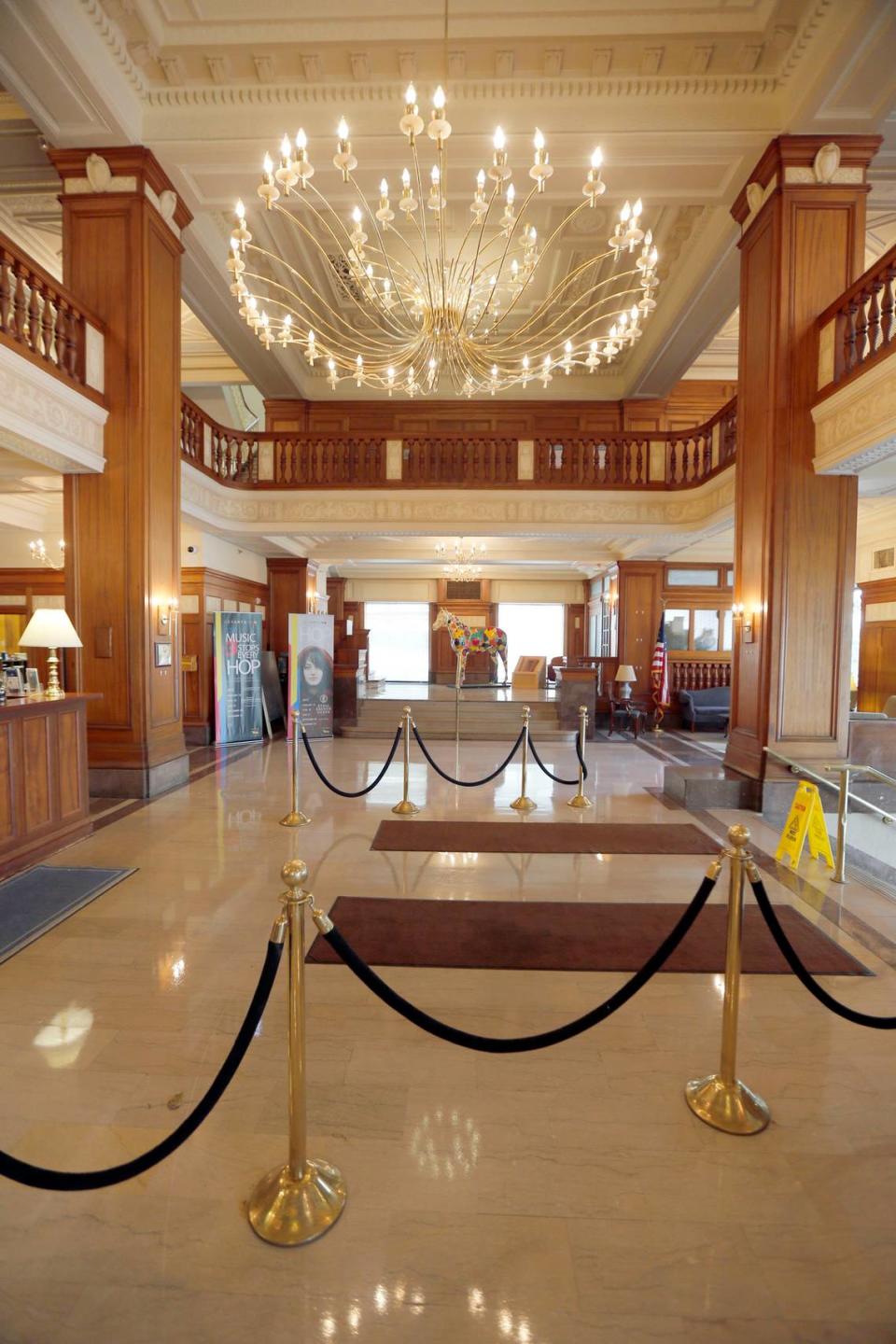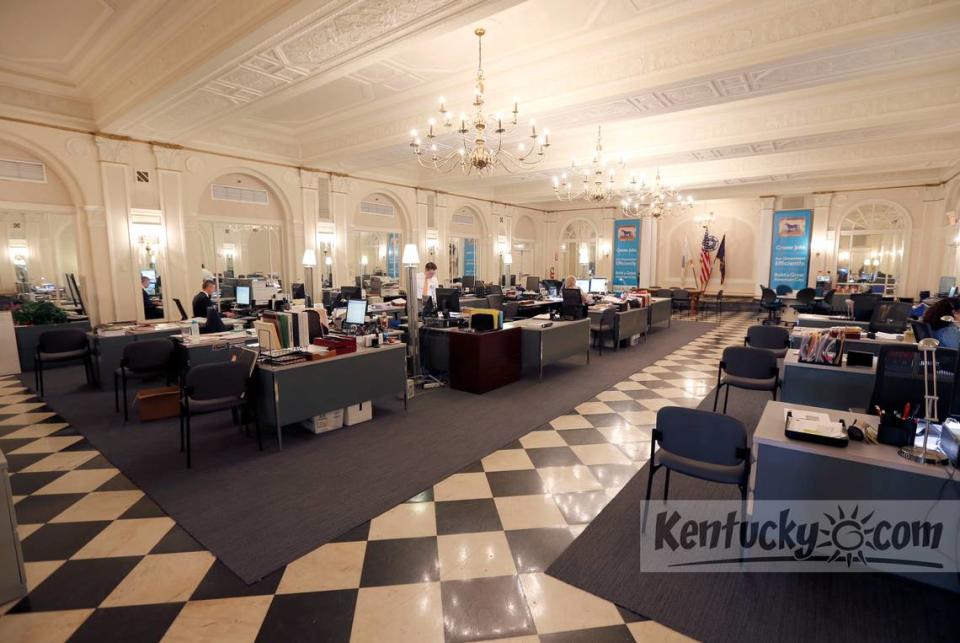Lexington looking for developer to plan new city government center in downtown
- Oops!Something went wrong.Please try again later.
Lexington is on the hunt for a new city hall.
Again.
On Tuesday, the city released a bid or request for proposals to developers for at least 166,000 square feet in the city’s downtown core — roughly between Midland Avenue and Jefferson Street, Church and Barr streets and Maxwell Street.
The bid said the city has a strong preference for the new building or buildings to be located along a downtown corridor including Main, Vine, Broadway or Midland Avenue.
The site requirements also include at least 130 parking spaces on or close to the site. In addition, there needs to be 500 parking spaces within walking distance of the downtown property, according to the request for proposals.
The proposal is for a private-public partnership. That means a private developer would develop or renovate a property and the city would lease it. The city would own the property after 35 years.

The new facilities would replace the city’s three main downtown buildings: the former Lafayette Hotel at 200 E. Main St., the attached Switow building at 212 E. Main Street, and the Phoenix Building, which is on Vine Street.
The city is not proposing using those buildings for a new combined city government center. The bid allows developers to develop proposals for use of city’s downtown properties. Those buildings could be sold to help pay for a new government center.
“A primary objective is to minimize upfront capital costs for the LFUCG while ensuring that we ultimately gain full ownership of both the land and the structure(s) within an agreed upon timeframe,” according to the request for proposals.
All proposals are due by Jan. 12.
Multiple proposals, multiple sites over decades
The city has been looking for a new city government center to replace its aging buildings in downtown Lexington for decades. When it moved into the former Lafayette Hotel in the 1980s, it was supposed to be a temporary home for the city’s merged government center.
It’s been there for decades.
The city’s core downtown operations are spread over three buildings, which can be confusing for visitors wishing to do business with the city. It’s also expensive to maintain the aging building. The Layette Hotel was completed in 1920 and is now more than 100 years old.
For example, the city has spent millions in recent years just fixing problems on the former hotel’s exterior.
Mayor Linda Gorton, who served on the council for 20 years prior to becoming mayor, said the city’s recent request for proposals is the fifth time the city has gone through the process.
Gorton said the city has done its due diligence and homework, and knows the types of space it needs. The current city buildings are also becoming too costly to maintain. For example, the elevators in the main government building recently had to be replaced.
“It was supposed to be temporary,” Gorton said of the former Lafayette Hotel.
Gorton said space needs have also changed over time. The buildings are not user-friendly or handicap accessible.
“We’ve already received interest,” Gorton said.
Still, a new city government site has been elusive, problematic and costly over the past two decades.

In 2018, under former Mayor Jim Gray, the city came close to getting a new home after a similar request for proposals to developers.
CRM Companies proposed renovating the former Lexington Herald-Leader building at 100 Midland Avenue for a four-story city government center. At the last minute, the Lexington-Fayette Urban County Council voted 7-5 to not move forward with the project, which was marred with questions about financing from the start. (Fayette County Public Schools has since purchased the building for a combined technical school.)
The proposal would have cost the city approximately $5.1 million a year over 35 years. However, that proposal included five downtown buildings, including the clerk’s office and the police department on Main Street. The new proposal does not include those buildings or employees.
That bid process was also stymied by a federal criminal investigation.
An executive of CRM Companies, Wayne Wellman, was eventually charged and convicted of using straw contributors to funnel money to two council members campaigns in an effort to circumvent campaign contributions limits.
After 2019, the city pursued land and a suitable building for a new city government center. Other locations that were considered included the Central Public Library site.
But those proposals were eventually nixed.
In 2023, the city hired Ernst & Young to study the spaces needs for the city. That study showed the city needed much less space than it had originally thought thanks largely to more city workers working remotely after the COVID pandemic.
That study also looked at proposed costs of renovating its current building or finding a new home.
The city has spent a lot of funds on studies about city hall.
Since 2016, it has spent $475,000 on studies alone for a new city government center.
The Ernst & Young study found renovating an existing downtown building would likely cost between $69 and $107 million. Building a new building would cost between $89 million and $139 million.
In comparison, staying in the city’s three current buildings and with just essential or basic modifications would cost between $78 million and $107 million. A full gut and renovation of all three properties would be costly — up to $135 million.
Another study conducted by Schrader Commercial Properties analyzed available downtown properties in the city’s core. It found two properties that could work but would need renovation or possible additions.
Those buildings include:
The Kentucky Utilities building on Water Street near the current city government building
The Truist Building at 200 W. Vine Street.
For a brand new building, which would include tearing down some structures, possible sites identified include:
The City National Bank Building and parking lot on Main and Rose streets
Parking lots at East High Street and Martin Luther King Boulevard
None of the properties are currently for sale. Schrader Properties also looked at other possible sites for a new city government including the YMCA’s High Street location and additional properties surrounding it. However, many of those properties had too many leases or owners and were deemed more difficult to develop.
Money for new city hall
There is $6 million for costs for design and procurement for a new city government center in the current-year budget. In addition, the council recently agreed to set aside a combined $36.6 million from a surplus for other costs associated with a new government center, a second senior center or a combined police and fire training facility.
The costs per year for a lease for a new city government center won’t be known until the city receives proposals. The previous proposed contract with CRM also required the private developer to set aside $3.1 million per year for maintenance costs.
A key question in the 2018 negotiations was how would maintenance issues be addressed and who — the developer or the city — would pay for those maintenance costs.
Gorton said the money that has been set aside could be used in a variety of ways, even to offset some of the yearly costs to lease the property.
Gorton said they hope to have the bids scored and analyzed by early March or April. Gorton delivers her budget proposal for the fiscal year that begins July 1 in late April.

